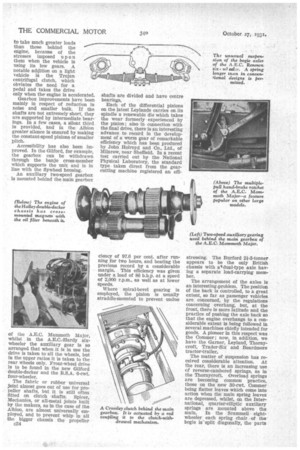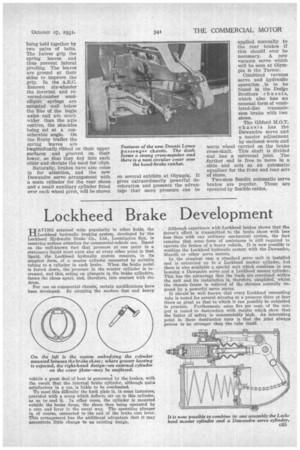TECHNICAL TENDENCIES
Page 82

Page 83

Page 84

Page 85

If you've noticed an error in this article please click here to report it so we can fix it.
IN MODERN C IASSIS DESIGN
Many Important Improvements Making for Safety, Ease of Operation, Smoother Running and Simplified Maintenance Better Design is Not Confined to any Particular Unit, but is Found Throughout the Chassis. Clever Points in Some Models
DURING the past few months a considerable number of new chassis has been placed on the British market, many of these showing considerable advances in design and, naturally, the other new chassis which will be exhibited at Olympia in November also embody remarkable features of interest, -Which proves that the commercialvehicle designer is fully alive to the need for keeping British products in the forefront Reasons for Improvements.
Certain features are necessarily the result of the new Ministry of Transport Regulations, others are included for various reasons, such as the more even distribution of the load on the wheels and the obtaining of better manceuvrability, whilst the needs of the maintenance engineer have by no means been neglected.
We are not, in this article, concerning ourselves with the oil engine; that will receive attention later. It will be convenient to deal with the various noints in the order in which they appear on a chassis, working from the front end. We will, therefore, commence with the means for cooling.
Radiators, as a rule, are much more prepossessing than formerly. Many utilize false shells, which are not only more easily finished in re
c82 spect of chromium-plating, etc., but act as a protection for the more vital parts. An instance of this is the shell on the Morris-Commercial 2-tonner, which acts also as a stone guard. Increasing use is being made of Still tubes, which are lighter and so efficient that only a few rows are required and less water need be carried. The Daimler type has a supplementary set of tubes to act as an oil cooler. In the Dennis Lance a corrugated stamp and a finned filter assist in keeping the oil at a low temperature.
In the main, the connections to them are of larger bore. In few instances, however, is use made of thermostats. The majority of fans is now driven direct from the timing gear through the medium of friction clutches, thus eliminating the often troublesome belt.
Power Unit Details.
Engines have been improved both in the power developed in relation to their weight and In detail design. A notable new arrival is the • Daimler poppet-valve type in which_ the timing gear is at the rear, where it is relieved from crankshaft oscillations. A number has transverse mounting of the magneto, as in the Halley doubledecker chassis, in which the oil filter is mounted in a most accessible position immediately beneath the magneto platform.
Another new engine is the Albion, with overhead valves operated by long bell-crank levers from a camshaft at the side—a valve arrangement which somewhat resembles that on the Guy. In the Leyland Cub is seen a reversion to sideby-side valves. Incidentally, this eiigine has a triple-roller timing chain and the tappet guides can lie re
moved in blocks of six to permit detachment of the valve springs. In many other engines Duplex roller chains are employed. Ricardo masked type inlet valves are being more favoured, and in =my units the cylinders are cast en bloc with the upper half of the crankcase, this being carried well below the line of the crankshaft and giving a high degree of Much use is being made of Improved materials, such as nickel east iron for the cylinders, which will give increased hardness in the thicker sections in addition to maintaining the machinability in the lighter parts. Where ordinary iron is employed,
cylinder liners, either of the wet type, as in the Halley, or of the dry type as in the Albion and others, are often employed, these being in nickel iron or centrifugally cast. In some instances they are hardened.
The pistons vary greatly. Some are of cast iron in various grades. others in aluminium alloy or combinations of steel and alloy, the main consideration in the latter two being to overcome any difficulty with unequal expansion and to reduce cylinder wear.
A method of locking gudgeon pins which is increasing in popularity Is the use of circlips. Connecting rods are mainly steel stampings, there being only one or two instances of the use of duralumin. Elektron metal Is being employed for crankcases, as well as for gearboxes and back-axle casings, the chief chassis using this being the A.E.C. and Bristol.
Simplified Engine Controls.
It is satisfactory to note the simplification of engine controls, as exemplified in the Halley, which uses Arens enclosed cables. Attention to valve seats during maintenance often involves the fitting of inserts, but now, in some engines such as the Leyland Cub and the Albion, the inserts are fitted during manufacture. When thoroughly secured they are more satisfactory than seats in the cylinder material as they can be made of first-class metal.
Nearly all engines are now mounted on rubber, most of them at three points, and in practically. •all models the engine, clutch and gearbox form a unit. Most of the engines Intended for the heavier classes. of vehicle have the auxiliaries grouped on the near side, so that the accessibility is not impaired when forward control is adopted. Such fittings as auxiliary oil filters and air filters are well to the fore.
The Design of Clutches.
There is practically standardization in respect of single-plate clutches, the improvements being chiefly in detail such as the securing of the fabric to the flywheel so that wear does not take place on this.
Reference must be made at this point to the highly efficient Daimler Fluid Flywheel, and the Crossley auxiliary clutch which is mounted behind the gearbox and controlled by a brake band actuated from the clutch pedal. This device greatly facilitates gear changing. Clutches of this description must be designed
to take much greater loads than those behind the engine, because of the stresses imposed upon them when the vehicle is using its low gears. A notable addition on a light vehicle is the Trojan centrifugal clutch, which obviates the need for a pedal and takes the drive only when theengine is accelerated.
Gearbox improvements have been mainly in respect of reduction in noise and smaller bulk. If the shafts are not extremely short, they are supported by intermediate bearings. In a few cases, a silent third is provided, and in the Albion greater silence is ensured by making the constant-speed pinions of smaller pitch.
Accessibility has also been improved. In the Gifford, for example, the gearbox can be withdrawn through the banjo cross-member which supports the unit and is in line with the flywheel housing.
An auxiliary two-speed gearbox Is mounted behind the main gearbox
of the A.E.C. Mammoth Major, whilst . in the A.E.C.-Hardy sixwheeler the auxiliary gear is so arranged that when it is in use the drive is taken to all the wheels, but in the upper ratios it is taken to the rear wheels only. Front-wheel drive is to be found in the new Gilford double-decker and the B.S.A. 6-cwt. four-wheeler.
The fabric or rubber universal joint almost goes out of use for propeller shafts, but it is still often fitted on clutch shafts. Spicer, Mechanics, or all-metal joints built by the makers, as in the case of the Albion, are almost universally employed, and to prevent whip in all the bigger chassis the propeller c34 shafts are divided and have centre bearings.
Each of the differential pinions on the latest Leylands carries on its spindle a renewable die which takes the wear formerly experienced by the pinion ; also in connection with the final drive, there is an interesting advance to record in the development of a worm gear of remarkable efficiency which has beau produced by John Holroyd and Co., Ltd., of Milnrow, near Sheffield. In a recent test carried out by the National Physical Laboratory, the standard type taken direct from the gearcutting machine registered an effi ciency of 97.6 per cent. after running for two hours, and beating the previous record by a considerable margin. This efficiency was given under a load of 86 b.h.p. at a speed of 2,000 r.p.m., as well as at lower speeds.
Where spiral-bevel gearing is employed, the pinion is usually straddle-mounted to prevent undue
stressing. The Burford 2i-3-tomer appears to be the only British chassis with aNdual-type axle having a separate load-carrying member,
The arrangement of the axles is an interesting !problem. The position of the back is controlled, to a great extent, so far as passenger vehicles are concerned, by the regulations concerning overhang, but, at the front, there is more latitude and the practice of pushing the axle back so that the engine overhangs to a considerable extent is being followed in several machines chiefly intended for goods. A pioneer in this respect was the Commer ; now, in addition, we have the Garner, Leyland, Thornycroft, Trader-Six and Beardmore tractor-trailer.
The matter of suspension has received considerable attention. At the rear, there is an increasing use of reverse-cambered springs, as in the Thornycroft. Overload springs are becoming common 'practice, those on the new 30-cwt. Commer being flatter leaves which come into action when the main spring leaves are depressed, whilst, on the International, quarter-elliptic auxiliary springs are mounted above the main. In the Scammell eightwheeler each spring chair . of the bogie is split diagonally, the parts
lieing held together by two pairs of bolts. The halves grip the spring leaves and thus prevent lateral pivoting. The leaves are ground at their sides to improve the grip. In the A.E.C. Renown six-wheeler the inverted and reversed-camber semielliptic springs are mounted well below the line of the bogie axles and are much wider than the axle centres, the shackles being set at a considerable angle. On the Braby trailer the spring leaves are longitudinally ribbed on their upper surfaces and grooved on their lower, so that they key into each other and obviate the need for clips.
Naturally, brakes have also come in for attention, and the new Dewandre servo arrangement with a main cylinder for the rear shoes and a small auxiliary cylinder fitted over each wheel pivot, will be shown on several exhibits at Olympia. It gives extraordinarily powerful deceleration and presents the advantage that more pressure can be applied manually to the rear brakes if this should ever be necessary. A new vacuum servo which will be seen at Olympia is the Turner.
Combined vacuum servo and hydraulic operation ,is to be found in the Dodge Brothers chassis, which also has an unusual form of ventilated-disc transmission brake with two shoes, The Gilford chassis has the Dewandre servo and a master adjustment by enclosed worm and worm wheel carried on the brake cross-shaft. This shaft is divided and has a universal joint. The farther end is free to move in a , slide and acts as an automatic equalizer for the front and rear sets of shoes.
Two-shoe Bendix automatic servo brakes are popular. These are operated by flexible cables.




































































































































































